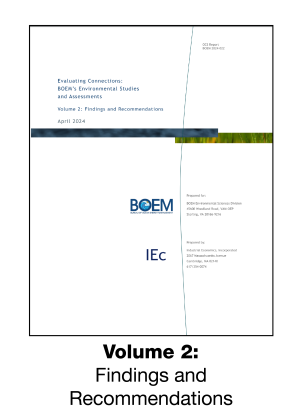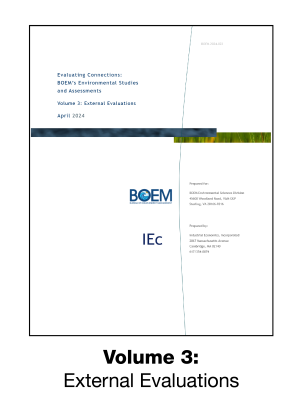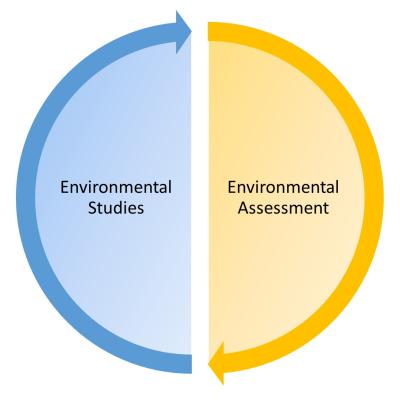Findings and Recommendations of Multi-Year Study
To understand the impact of BOEM’s environmental studies and assessments on each other and external audiences, Industrial Economics, Incorporated (IEc) conducted research and analysis that culminated in a three-volume report of data, insights, and recommendations.
Click the links to download each volume.
Scope of the Study
- 20 years of environmental studies and assessments* (1999–2019)
- 256 environmental assessments*
- 876 completed environmental studies
- 125 interviews
- 184 survey responses
* For this project, “assessment” is not restricted to NEPA environmental assessments but encompasses the many types of analyses that BOEM undertakes, such as national historic preservation documents, Essential Fish Habitat assessments, biological evaluations, government-to-government consultations, resource evaluations, site assessments, etc.
BOEM’s environmental studies and assessments play a critical role by informing
- Mitigation measures
- NEPA reviews
- Consultations
- Models
- Follow-on studies
- Oil spill risk analysis
- Resource identification
- Policy changes
How well do assessments inform section of new studies?
- Topics with more information needs received more funding.
- BOEM also pursues studies based on anticipated needs for future assessments.
- Strong agreement among staff that BOEM develops studies based on information needs for assessments.
How well do studies inform assessments?
- About 80% of BOEM assessments cited at least one BOEM study.
- The average number of BOEM studies cited by BOEM assessments was 12.
- Majority of staff surveyed agreed that BOEM studies are useful to BOEM assessments.
Study found a well-connected, active network within BOEM. Top three methods for communicating study findings in BOEM:
- Word of mouth
- Study reports
- Presentations.
Survey responses on how people receive information about BOEM studies and assessments. Surveys conducted before the Environmental Studies Program Information System (ESPIS) was discontinued.
How do people outside of BOEM receive information on BOEM studies?
Survey Response: Most common method is directly from BOEM staff.
| Method | Responses |
|---|---|
| Direct interactions w/ BOEM | 87% |
| BOEM website | 53% |
| ESPIS | 51% |
| Conferences | 51% |
| Direct interaction with non-BOEM federal staff | 47% |
| Webinars | 47% |
| Internet searches | 44% |
| Direct interactions with academics | 40% |
| BOEM newsletter | 22% |
| Direct interaction with state staff | 13% |
| Other | 9% |
How do people outside of BOEM receive information on BOEM assessments?
Survey Response: Most common method is directly from BOEM staff.
| Method | Responses |
|---|---|
| Direct interactions w/ BOEM | 93% |
| BOEM website | 68% |
| Internet searches | 54% |
| Direct interaction with non-BOEM federal staff | 50% |
| Webinars | 50% |
| Direct interactions with academics | 46% |
| Conferences | 32% |
| Public meetings | 29% |
| BOEM newsletter | 25% |
| Direct interaction with state staff | 18% |
| Public notices of NEPA documents | 11% |
| Other |
Academic researchers and federal agencies like NOAA, USGS, and USFWS play a critical role in disseminating BOEM science outward to other external stakeholders by sharing information with their own networks and helping to expand the reach of BOEM science.
Number of Articles and Citation Counts for Top-referenced Journal Articles Resulting from BOEM Studies
| Topic Area | Publications | Average Number of Citations (Google Scholar) |
|---|---|---|
| Oil and Gas Surveys and Extraction | 749 | 71.2 |
| Oil Spill | 246 | 86.4 |
| Renewable Energy Development/Wind | 72 | 36.8 |
| Climate Change | 56 | 76.4 |
| Marine Minerals Extraction | 50 | 82.9 |
| Submarine Transmission Lines | 43 | 16.7 |
| General BOEM Activities | 21 | 37.7 |
| Fisheries Use and Management | 19 | 17.9 |
Note: Some publications fell within multiple topic areas.
What is the impact of BOEM’s scientific research on the external environmental community?
(e.g., other federal agencies, state agencies, academia)?
- Directly influence decision making outside of the Bureau, particularly in the context of coastal and marine resource management for federal and state agencies
- Fill critical knowledge gaps and meaningfully advance ocean scientific research
- Generate new information on impacts of offshore renewable energy
- Advance basic scientific research
- Inform other entities’ funding decisions
- Contribute to publicly available databases
- Inform natural resource decision-making and policy development at multiple jurisdictional levels
- Inform stakeholder understanding of ocean science






